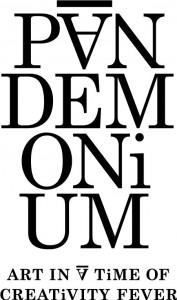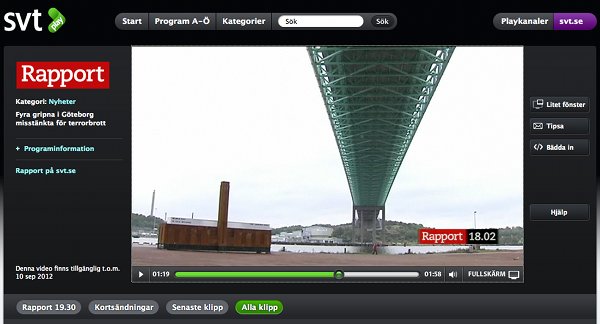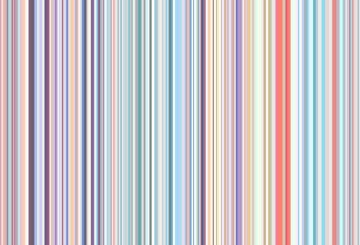Sign o’ the devil? Maybe, reports John Kelly from The Göteborg International Biennale of Contemporary Art…
pandemonium,noun, wild and noisy disorder or confusion; uproar : pandemonium broke out. ORIGIN mid 17th cent.: modern Latin (denoting the place of all demons, in Milton’s Paradise Lost), from pan- [all] + Greek daim?n ‘demon.’
OK, what creative demon turned that A upside down? Was it an ‘rtist’? Was it creative graphic designer? OK, where did that A go?
The alphabet inversions accompany the literature for this year’s Göteborg International Biennale of Contemporary Art (GIBCA), but we don’t really know who is ‘cow tipping’ [1] the As. What we do know is that an A with an angelic halo is a letter in the Swedish alphabet that has a completely different sound to what we english speakers are used to.
Language is crucial to creative thinking and text is a manifestation of communicative language using letters that relate to sound to form the building blocks of text. It is within early biblical texts that angels and demons first fought each other, in an imaginary world that has helped us to evolve to the point at which we now have the tools for everybody to be creative, even you the reader. Go on you little –
demon, noun, 1 an evil spirit or devil, esp. one thought to possess a person or act as a tormentor in hell; a cruel, evil, or destructive person or thing : I was a little demon, I can tell you; [often as adj. ] a forceful, fierce, or skilful performer of a specified activity : a friend of mine is a demon cook | a demon for work; reckless mischief; devilry : his eyes are bursting with pure demon.
Göteborg International Biennale Röda Sten Konsthall venue; photo: author
It’s September 11, 2011. A group of artists and curators is sitting in the lounge of the Scandic Crown Hotel in Göteborg, Sweden. They drink and relax after a long week of installing and then celebrating the opening of GIBCA. The flatscreen TV above them is showing the commemoration ceremony to mark the World Trade Center attacks ten years earlier. The report shows the square gardens that now occupy the footprints of the destroyed towers. The garden of remembrance is dedicated to those who died in the twin towers, which were attacked so dramatically and militarily creatively and – from that perspective – you could also say successfully. Ten years on, it seems the attacks have come close to defeating America: I don’t mean militarily, but economically. Just as Ronald Reagan is credited with creatively (remember Star Wars) driving an arms race that eventually brought down the Soviet Union, al-Qaeda seems to have set off a chain of events that has left the United States (and the West’s) economic prosperity in tatters. The cost of waging a war on an abstract noun (Terror) and the determination to hunt down and kill one man, has come at a high price, a very high price that has run the American economy into the ground. I’m sure the military strategist Sir Basil Liddell-Hart would have described al-Qaeda’s actions as a textbook example of his indirect approach. Liddell-Hart tells us:
In strategy, the longest way round is often the shortest way there; a direct approach to the object exhausts the attacker and hardens the resistance by compression, whereas an indirect approach loosens the defender’s hold by upsetting his balance.
Göteborg International Biennale Röda Sten Konsthall venue; photo: author
One could imagine Osama bin Laden studying Liddell-Hart, while George W Bush seemed to come from a Hollywood western when he said:
…there’s an old poster out West, I recall, that says, ‘Wanted: Dead or Alive’.
I, pronoun [ first person singular ] used by a speaker to refer to himself or herself : accept me for what I am. noun ( the I) Philosophy (in metaphysics) the subject or object of self-consciousness.
A few days earlier, I was sitting in the same hotel lounge talking to a Cherokee Indian, from Rome, called Jimmy Durham. He talked in a way that was soothing, weaving disparate narratives and then bringing them together at the end with some humorous observation. It brought back memories of the BBC World Service and the voice of Alistair Cooke in his weekly Letter from America, which I used to listen to in Australia.
I enjoyed Durham’s company in the lounge as that same flatscreen TV flashed images of Adolf Hitler in the corner. Shot from below, his image was interspersed with bombers flying across the screen. As it was early September, I assumed it was commemorating the start of the Second World War.
Hitler’s sketches (1925) for a triumphal arch
The night before, Durham had spoken at the ‘Speakeasy’, a self-organised event associated with GIBCA. This is where I first learnt about his project, which is to bring to light the existence of what has come to be known as the ‘Hitler Stones’. These carved granite stones were ordered from Sweden, but were never delivered, for what Durham humorously calls ‘historical reasons’.
Durham waxed eloquent about Hitler’s proposed victory arch. At one point Durham planned to film the dumping of the remaining stones at sea. The enormous structure is illustrated in the Biennale by a reproduction of a drawing by Hitler himself; the size of the monument is graphically illustrated by the dots representing people at its base. The artist’s ‘anti-monumentalism’ stance, juxtaposed against the opening of the 9 /11 remembrance gardens, seemed poignant. With the names of the dead inscribed in stone in the gardens, text replacing their physical being, Ground Zero becomes a twenty-first-century tombstone. Tombstone: that place famous for its connection with the gunfight at the OK Corral that Hollywood simplified into the good (the Law) versus the bad (outlaws or cowboys). Tombstone in reality was a town in which:
Under its violent surface simmered leftover resentments from the Civil War: local Confederate sympathizers against Northern-allied lawmen viewed as carpetbaggers; partisan politics: Republican Earps vs. Democrat Clantons and McLaurys; and the fundamental conflict over resources and land, of Northern-style “big-government” development vs. traditional “small-government” agrarianism. [Earp’s supporters] wanted a government powerful enough to make southern Arizona safe for capitalism [2]
John Kelly: The Garden Shed, 2011, interior shot; courtesy the artist / author
History is always far more complex than what we get presented with, and yet artists are often responsible for presenting history – whether these monuments are created in steel, stone, glass, film or text. Artists in the broader sense of that word tend to create these simplified markers that point to a far more complex history. It’s why monuments are often destroyed – like the sculpture of Saddam Hussein being pulled to the ground during the Iraq war.
um, exclamation, expressing hesitation or a pause in speech : anyway, um, where was I?
Go back to the Scandic Crown Hotel, just before the news crosses to New York and the 9 / 11 commemoration. There is another story. It opens with an image of a police crime tape crossing a darkened road, cutting to a sign that reads ‘Röda Sten Konsthall’, then to the Director of this arts centre, Mia Christersdotter Norman. The sound is down, so we can’t hear what is being said, but we already know that this news item is not about the exhibition. The night before, the party to open GIBCA had been cut short. The reason was that management had been told by police that there was a credible terrorist threat to life and property. The news revealed the arrest of four suspects on charges of plotting a terrorist attack (later changed to plotting murder).
News item on suspected terrorists; item here
The Swedish news moves from the actual event to using footage from Sky News, presumably to illustrate the international coverage that these arrests are receiving. The report ends with a shot of my work, The Garden Shed, which is outside the Röda Sten. This sculpture is a 40ft by 25ft sculptural interpretation of the Tate Modern.
The next day, it’s noticeable that the printed media avoid showing my sculpture. A London landmark in Sweden? I can imagine the picture editor realising the confusion such an image would cause.
pan 1 |pan| noun 1 a container made of metal; an amount of something contained in such a container; a large container used in a technical or manufacturing process
The Garden Shed looks tiny juxtaposed against the Alvsborg Bridge, yet it is a monumental Cor-ten steel sculpture made from a large sea container. It represents something that is even bigger. It is also a Trojan Horse, carrying a complete exhibition inside, including other smaller models of the Tate Modern. It begins with Room 6, level 3 of the former Bankside power station. Inside I have placed N.M. Cummins’s 1846 letter relating the plight of the starving Irish on South Reen peninsula in Co Cork, which is where I now live.
Cummins’s letter is juxtaposed against another work at the other end of the container, titled Mum and Dad @ Tate Modern. Inside this model two video screens show my mother and father talking simultaneously. My father explains his journey from Ireland to Australia. On the other screen my mother describes my journey to becoming an artist and traveling back to Ireland to live.
Between Cummins’s letter and my father is a military event that is not in the steel container: the 1916 Easter rising in Ireland, an event whose politics grew out of An Gorta Mór (The Great Hunger) and arguably the aftermath of which that led to the Irish state and the economic conditions that forced my father’s emigration.
Hanging from the ceiling is Halo. When you stand inside this work, you can look into small galleries of pristine whiteness where I have created small paintings and sculptures of works I once made in Australia. Some of these paintings are of ‘camouflage cows’ that allude to two Australian artists’ work during the Second World War. Their job was to make papier-mâché cows that were moved around grass airfields in the hope of fooling Japanese airmen. Said one of the artists: “I think the authorities underestimated the eyesight of Japanese airmen.”
John Kelly: The Garden Shed (detail), 2011, interior shot; courtesy the artist / author
Two artists, putting their creativity to work for a war effort, mimics the fascinating fact that another two artists also put their creativity to work for their countries. It’s stranger than fiction that the most destructively murderous event of the twentieth century was fought between two artists who both enjoyed painting watercolors. These were of course, Adolph Hitler, who failed to gain acceptance at an Austrian art academy, and Winston Churchill who, when not orating, smoking, drinking or writing, liked nothing more than to sit down and paint. And people ask are the arts important?
And what creative individual has been messing with our A’s? I found this clue in Göteborg, not far from the Scandic Crown hotel:
John Kelly
www.johnkellyartist.com
1. Cow tipping is the activity of sneaking up on a sleeping, upright cow and pushing it over. Cow tipping is really a myth: cows do not sleep standing up.
2. http://blog.theautry.org/2010/04/28/the-o-k-corral-documents/











As ever, Kelly has firmly grasped the wrong end of the stick.